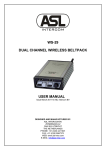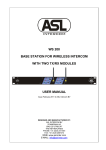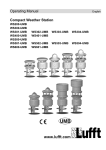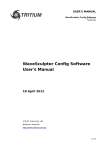Download User Manual WS 19
Transcript
WS-400 BASE STATION FOR WIRELESS INTERCOM WITH FOUR TX/RX MODULES USER MANUAL Issue February 2011 © ASL Intercom BV DESIGNED AND MANUFACTURED BY: ASL INTERCOM BV ZONNEBAAN 42 3542 EG UTRECHT THE NETHERLANDS PHONE: +31 (0)30 2411901 FAX: +31 (0)30 2667373 WEB: www.asl-inter.com E-MAIL: [email protected] CONTENT OF THIS USER MANUAL 1.0 INTRODUCTION ................................ 3 2.0 UNPACKING ................................... 3 3.0 INSTALLATION ................................. 3 4.0 WARRANTY ................................... 3 5.0 FRONT PANEL CONTROLS ....................... 4 6.0 REAR PANEL CONTROLS & CONNECTORS ........... 4 7.0 AUTOMATIC AUDIO ROUTING ..................... 5 8.0 THE INTERFACE TO WIRED INTERCOM ............. 6 9.0 FREQUENCY BAND & ANTENNA‟S .................. 6 10.0 SETTING UP CONNECTIONS ...................... 6 11.0 COMMMUNICATION MODES ...................... 9 12.0 TECHNICAL SPECIFICATIONS WS 400 .............. 9 PAGE 2 User Manual WS-400 / February 2011 © ASL Intercom BV . 1.0 INTRODUCTION The WS-400 is designed to be the base station for wireless beltpacks WS-19 (single channel) or WS29 (dual channel). It contains four transmit/receive (TX/RX) modules and is housed in a strong steel 19” /1RU case. On the front panel of the WS-400 are various TX/RX controls and the antenna connectors. Via XLR-3 connectors on the rear panel the TX/RX modules in the WS-400 can be linked to either a party line or a 4-wire intercom system. ASL uses the 2.4 GHz frequency band for the communication between its wireless beltpacks and base stations. A maximum of 8 full duplex wireless connections can be made, simultaneously operated without any interference. For 8 connections are needed either 2x WS-400, or 1x WS-400 + 2x WS200, or 4x WS200. (The WS-200 base station contains two TX/RX modules). 2.0 If any are missing, contact your dealer. A TX/RX module in a base station automatically senses whether a WS-19 or a WS-29 beltpack is assigned. The on-board micro processor routes the audio as required for either beltpack type. See section 7 “Automatic Audio Routing. . ASL has taken great care to ensure this product reaches you in flawless condition. After unpacking the unit please inspect for any physical damage to the unit, and retain the shipping carton and relevant packing materials for use should the unit need returning. If any damage has occurred, please notify your dealer immediately so that a written claim can be initiated. Please also refer to the warranty section of this manual. INSTALLATION The unit has to be connected to a mains outlet (90 - 240 V AC, 50/60 Hz). IMPORTANT NOTICE: The green/yellow wire of the power cord must always be connected to the electrical installation safety earth or ground. This is essential for personal safety as well as for proper functioning of the WS-400 4.0 A wireless beltpack (the WS-19 as well as the WS29) contains one TX/RX module. Each beltpack needs to be assigned to a unique TX/RX channel. If another TX/RX module is set to the same TX/RX channel communication is garbled or not possible at all. UNPACKING The shipping carton contains the parts listed below: o The WS-400 o User manual o Four antenna‟s o Power cord o Spare fuses 3.0 In case in the same space more than one base station is required, these stations have to be interconnected by WS Link Cables (an ASL accessory product). A link cable contains all signals which have to be interchanged between base stations and are connected to the Sub-D Link connector on the rear panels. Switch the WS-400 on with the power switch at the rear panel and adjust the channel select switch of one of the TX/RX modules to match the selected TX/RX channel on one of your wireless beltpacks.. The WS-400 should now have contact with this beltpack. To check this, push the CALL or TALK button on the beltpack and the green LED of the corresponding TX/RX module in the WS-400 should be lit. See also section 10 „Setting up Connections and section 11 „Communication Modes‟ WARRANTY This unit is warranted by ASL Intercom to the original end-user purchaser against defects in workmanship and materials in its manufacture for a period of one year from date of shipment to the enduser. Faults arising from misuse, unauthorized modifications or accidents are not covered by this warranty. If the unit is faulty it should be sent in its original packing, to the supplier or your local ASL dealer, with shipping prepaid. A note must be included stating the faults found and a copy of the original suppliers invoice. PAGE 3 User Manual WS-400 / February 2011 © ASL Intercom BV . 5.0 FRONT PANEL CONTROLS 1 RX active LED This LED will be lit when the RX/TX Unit receives data from an active beltpack (Talk and/or Call). When a beltpack is only listening it will not be lit. 2 Audio Routing LED indicators Indicate the audio routing for either a WS-19 single channel beltpack or a WS-29 dual channel beltpack. See section 7.0 “Automatic Audio Routing” 3 SIDE TONE trimmer This trimmer adjusts the level of your own voice as you hear it in the headset which is connected to your wireless beltpack. The operating area is between fully clockwise and minimum level. 6.0 Adjusting the side tone does not affect the level of your voice as it is heard by other stations. For adjustment procedure, see section 10 “Setting up Connections” 4 Channel Select switch With this switch the TX/RX channel is selected on which the base station communicates with the beltpack. There is a choice out of 8 TX/RX channels. The selected TX/RX channel must match the TX/RX channel which is selected on the beltpack. See also section 9.1 “Frequencies”. 5 ANTENNA connector On this connector the supplied antenna‟s are to be connected. REAR PANEL CONTROLS & CONNECTORS On the WS-400 rear panel are the controls & connectors of channel A, B, C and D. The drawing shows the controls & connectors of only channel A and B. 6 INTERFACE MODE switch This switch determines the mode of the audio interface and the function of the XLR connectors #9 and #10. See section 8 “The Interface to Wired Intercom” 10 INPUT connector This female XLR-3 connector is for connecting either party line wired intercom or 4-wire intercom. See section 8 “The Interface to Wired Intercom”. 7 OUTPUT LEVEL trimmer This trimmer adjusts the output level of the audio signal that comes from the beltpack. 11 LINK connector This Sub-D connector contains all signals that need to be interchanged when two or more base stations are to be used in the same space. Only use the special WS link cable supplied by ASL. 8 INPUT LEVEL trimmer This trimmer adjusts the input level of the audio signal that is sent to the wireless beltpack. 9 OUTPUT connector This male XLR-3 connector is for connecting either party line wired intercom or 4-wire intercom. See section 8 “The Interface to Wired Intercom”. 12 MAINS switch With this switch the WS-200 can be switched on or off. 13 MAINS connector with fuse holder This mains input accepts 90 – 240 V AC, 50 – 60 Hz. The fuse in the fuse holder needs to be 1.25 Amp of the slow blow type. The bottom part contains a spare fuse. PAGE 4 User Manual WS-400 / February 2011 © ASL Intercom BV . 7.0 AUTOMATIC AUDIO ROUTING To a TX/RX module in the WS 400 one can assign either a WS-19 single channel beltpack or a WS-29 dual channel beltpack. The on-board micro processor automatically detects either beltpack type and routes the audio as follows: Section of WS-400 front panel Section of WS-400 rear panel o When a WS-19 beltpack is assigned to the TX/RX-1 module, the front panel top LED (labeled “1-ch beltpack”) is lit. The audio to/from this beltpack is routed from/to the rear panel XLR-3 connectors “Channel A”. o When a WS-19 beltpack is assigned to the TX/RX-2 module, the front panel top LED (labeled “1-ch beltpack”) is lit. The audio to/from this beltpack is routed from/to the rear panel XLR-3 connectors “Channel B”. o When a WS-19 beltpack is assigned to the TX/RX-3 module, the front panel top LED (labeled “1-ch beltpack”) is lit. The audio to/from this beltpack is routed from/to the rear panel XLR-3 connectors “Channel C”. o When a WS-19 beltpack is assigned to the TX/RX-4 module, the front panel top LED (labeled “1-ch beltpack”) is lit. The audio to/from this beltpack is routed from/to the rear panel XLR-3 connectors “Channel D”. When a WS-29 beltpack is assigned to the TX/RX-1 or the TX/RX-2 module, the front panel middle LED (labeled “2-ch beltpack”) is lit. The audio from/to channel A of this beltpack is routed to/from the rear panel XLR-3 connectors “Channel A” and the audio from/to channel B of this beltpack is routed to/from the rear panel XLR-3 connectors “Channel B”. o When a WS-29 beltpack is assigned to the TX/RX-3 or the TX/RX-4 module, the front panel middle LED (labeled “2-ch beltpack”) is lit. The audio from/to channel A of this beltpack is routed to/from the rear panel XLR-3 connectors “Channel C” and the audio from/to channel B of this beltpack is routed to/from the rear panel XLR-3 connectors “Channel D”. PAGE 5 User Manual WS-400 / February 2011 © ASL Intercom BV . 8.0 THE INTERFACE TO WIRED INTERCOM Each TX/RX module in the WS-400 contains an interface to wired intercom. The interface can be put in “Party Line Mode” or in “4-Wire Mode”, using the Interface Mode Switch on the rear panel. Party Line Mode (the Mode switch is not pushed): The XLR-3 male connector (#9) and the XLR-3 female connector (#10) on the rear panel are now “party line connectors” for daisy chain wiring purposes. The audio is sent from the wireless beltpack to the party line of the wired intercom system and from this system to the wireless beltpack. In this mode the base station also handles all CALL functions to and from the party line intercom and MIC MUTE functions from the party line intercom. 4-Wire Mode (the Mode switch is pushed): The XLR-3 male connector (#9) and the XLR-3 female connector (#10) on the rear panel are now “4-wire connectors” The female connector is the electronically balanced input connector for audio from the 4-wire intercom system to the wireless beltpack. The male connector outputs the audio signal from the wireless beltpack to the 4-wire intercom system as an electronically balanced signal. FREQUENCY BAND & ANTENNA’S 9.0 9.1 Frequencies ASL‟s wireless intercom uses the 2.4 GHz band, which is freely available for WLAN (Wireless Local Area Networks). The ASL system divides the available bandwidth into 16 overlapping sections, 8 of them being used as upload frequency (from the beltpack to the base station) and the other 8 being used as download frequency (from the base station to the beltpack). With the channel select switches on base stations and wireless beltpacks one actually selects an upload / download pair, called a TX/RX channel. Each TX/RX channel serves one dedicated wireless connection between base stations and wireless beltpacks (in fact between the TX/RX modules in those units). It is possible to have several WS 19 beltpacks on the same TX/RX channel, see section 10.2 “Half Duplex”. When using the ASL wireless system, the following should be taken into account: o The 2,4 GHz frequency is known to have difficulty in penetrating concrete walls, steel walls and other obstructions. Behind obstructions like these an “HF shadow” may occur where no communication is possible. o o The antenna‟s of a base station should have as much as possible a “line of sight” to the antenna‟s of the beltpack(s). All objects within that path make the connection less reliable. Due to reflections of the HF signal, one might experience a dropout on a specific spot in a building; moving a beltpack only a few inches can be enough to solve the problem. Because of the use of the WLAN frequencies, ASL‟s wireless units might experience interference from units like mobile telephones with bluetooth and computers with bluetooth or WLAN cards. Try to change TX/RX channels if you experience problems with these. 9.2 Antenna Wiring (Base Stations) If the antennas of a base station are not supposed to be directly connected to its front panel, a cable between base station and antenna is needed (base stations are equipped with SMA connectors - female at the base station and male at the antenna). The 2.4GHz frequency experiences a big loss in any cable, e.g. a RG58 cable has a loss of 1 dB per meter. So make sure that your cable (50 ohms) is suited for 2.4 GHz and that the cable is as short as possible. Make the cables in lengths of a multiple of 12, e.g. lengths of 24cm, 48cm, 120cm, 240cm etc. 10.0 SETTING UP CONNECTIONS 10.1. ASL WIRELESS AS A STAND ALONE SYSTEM 10.1.1 Base Station Settings a. Give each TX/RX module in the base station its own TX/RX channel by rotating the „Channel select‟ switch. Try to avoid TX/RX channels to be physically next to each other, e.g. when two WS-400‟s are in your wireless system, try to set them in this order: TX/RX channels 2, 4, 6, 8, 1, 3, 5, 7. If one uses a WS-200 with only two beltpacks, use TX/RX channels 1 and 6 b. Make sure the interface mode switch at the rear of the base station is set to “PARTY LINE”. The internal party line is now linking the on board TX/RX modules to each other. c. Turn down the side tone trimmers at the TX/RX modules (counter clockwise) PAGE 6 User Manual WS-400 / February 2011 © ASL Intercom BV . 10.1.2 Wireless Beltpack Settings d. With the Channel Select switch at the rear of the beltpack, select the TX/RX channel according to the WS-200 or WS-400 setting e. Connect a headset to the beltpack and insert fully charged batteries. When the beltpack is switched on, a single short tone should be heard and both LED‟s on the front panel of the unit flash for half a second. This indicates that the beltpack is functioning properly. f. When one pushes the CALL or the TALK button, the LED‟s on the front panel are lit and the green LED of the corresponding TX/RX module in the base station is lit. It proofs the beltpack has connection with the base station 10.2 g. Turn down the OWN VOICE Volume trimmer at the side panel of the beltpack (counterclockwise) h. Set the volume control of the beltpack at approximately 50% i. Push the TALK button on the beltpack, talk into the headset microphone and listen to your own voice (you might hear a small delay ) j. Adjust the side tone trimmer at the referring TX/RX module in the base station so that the level of your own voice is as low as possible k. Adjust the OWN VOICE trimmer on the beltpack so that the level of your own voice is to your liking. ASL WIRELESS CONNECTED TO A 4-WIRE INTERCOM SYSTEM 10.2.1 Base Station Settings a. Give each TX/RX module in the base station its own TX/RX channel by rotating the „Channel select‟ switch. Try to avoid TX/RX channels to be physically next to each other, e.g. when two WS-400‟s are in your wireless system, try to set them in this order: TX/RX channels 2, 4, 6, 8, 1, 3, 5, 7. If one uses a WS-200 with only two beltpacks, use TX/RX channels 1 and 6 b. Make sure the interface mode switch at the rear of the base station is set to “4-WIRE” The internal party line is now disconnected. c. Connect the 4-wire intercom system via the XLR-3 connectors at the rear panel of the base station. Each XLR-3 male connector (signal out) and female connector (signal in) connects each TX/RX module to an input/output of the a 4-wire intercom system. 10.2.2 Wireless Beltpack Settings d. With the Channel Select switch at the rear of the beltpack, select the TX/RX channel according to the WS-200 or WS-400 setting. e. Connect a headset to the beltpack and insert fully charged batteries. When the beltpack is switched on, a single short tone should be heard and both LED‟s on the front panel of the unit flash for half a second. This indicates that the beltpack is functioning properly. f. When one pushes the CALL or TALK button, the LED‟s on the front panel are lit and the green LED of the corresponding TX/RX module in the base station is lit. 10.3 It proofs the beltpack has connection with the base station. g. Turn down the OWN VOICE Volume trimmer at the side panel of the beltpack (counterclockwise) h. Push the TALK button on the beltpack, talk into the headset microphone and listen to your own voice i. Turn up the volume of your own voice by adjusting the OWN VOICE trimmer to a level of your liking ASL WIRELESS CONNECTED TO A PARTY LINE INTERCOM SYSTEM 10.3.1 Base Station Settings a. Give each TX/RX module in the base station its own TX/RX channel by rotating the „Channel select‟ switch. Try to avoid TX/RX channels to be physically next to each other, e.g. when two WS-400‟s are in your wireless system, try to set them in this order: TX/RX channels 2, 4, 6, 8, 1, 3, 5, 7. If one uses a WS-200 with only two beltpacks, use TX/RX channels 1 and 6 b. Make sure the interface mode switch at the rear of the base station is set to “PARTY LINE”. c. Connect the party line intercom system via the XLR-3 connectors at the rear panel of the base station. Each XLR-3 male and female pair may connect each TX/RX module to a channel of the party line intercom system (see also section 10.3.3). Everywhere this connection is made, the internal party line is interrupted d. Turn down the side tone trimmers (counter clockwise). PAGE 7 User Manual WS-400 / February 2011 © ASL Intercom BV . 10.3.2 Wireless Beltpack Settings e. With the Channel Select switch at the rear of the beltpack, select the TX/RX channel according to the WS-200 or WS-400 setting f. Connect a headset to the beltpack and insert fully charged batteries. When the beltpack is switched on, a single short tone should be heard and both LED‟s on the front panel of the unit flash for half a second. This indicates the beltpack is functioning properly g. When one pushes the CALL or TALK button, the LED‟s on the front panel are lit and the green LED of corresponding TX/RX module of the base station is lit. It proofs the beltpack has connection with the base station h. Turn down the OWN VOICE Volume trimmer at the side panel of the beltpack (counter-clockwise) i. Set the volume control of the beltpack at approximately 50% j. Push the TALK button on the beltpack, talk into the headset microphone and listen to your own voice (you might hear a small delay in the signal) k. Adjust the side tone trimmer of the referring TX/RX module in the base station so that the level of your own voice is as low as possible l. Adjust the OWN VOICE trimmer on the beltpack so that the level of your own voice is to your liking. 10.3.3 Wiring Configurations when connecting to party line intercom systems Connecting to party lines can be done in many different ways. Below a few examples: Example 1: When two WS-400 base stations are installed and 8x WS-19 single channel beltpacks are available: The drawing shows how to connect all WS-19‟s to the same party line. Example 2: When two WS-400 base stations are installed and 8x WS-19 single channel beltpacks are available: The drawing shows how to connect WS-19 #1 and #2 to party line 1, WS-19 #3 and #4 to party line 2, WS-19 #5 and #6 to party line 3 and WS-19 #7 and #8 to party line 4. Example 3: When two WS-400 base stations are installed and 8x WS-29 dual channel beltpacks are available: The drawing shows how to connect channel A of all WS-29‟s to party line 1 and channel B of all WS 29‟s to party line 2. For connecting base station TX/RX modules via their XLR-3 male and female connectors on the rear panels (see drawings above) , use short microphone cables. PAGE 8 User Manual WS-400 / February 2011 © ASL Intercom BV . 11.0 11.1 COMMMUNICATION MODES Full Duplex Mode (for WS-19 and WS-29 beltpacks) A full duplex wireless connection is accomplished by using a dedicated TX/RX channel, selected on the beltpack and on the base station. 11.2 Such a TX/RX channel links the TX/RX module in a wireless beltpack to one of the TX/RX modules in the base station. Half Duplex Mode (for WS-19 single channel beltpacks only). This mode allows more than one WS-19 beltpacks on the same TX/RX channel. However, only one of the WS 19 beltpacks can talk at a time and have a full duplex connection. For as long as one of the beltpacks has a full duplex connection (talk, listen and call), the other beltpacks are able to listen to the signals coming from the base station, but are not able to call or talk. In case of half duplex use of WS-19 beltpacks whilst the corresponding TX/RX module in the base station is connected to a wired party line intercom system, the following has to be taken into account: The side tone prevents (when properly adjusted) the microphone signal coming from the “talking beltpack” to return to the beltpacks. The “listening beltpacks” do not hear the “talking beltpack”. To solve this, the side tone trimmer of the concerning TX/RX module should be turned down (fully counter clockwise). But there is a drawback: the user of the “talking beltpack” will hear his own voice with a delay of 24 msec and via the OWN VOICE link in the beltpack (no delay). The effect of hearing your own voice twice (with and without delay) can be diminished by turning down the OWN VOICE trimmer. The “listening beltpacks” will not notice the delay. 12.0 TECHNICAL SPECIFICATIONS WS 400 Mains Mains power: 90 - 40 V AC, 50/60 Hz Fuse: 1250 mA T Power Consumption: max. 25 Watt Input Amplifiers (4-wire mode) input impedance: min. 10 kOhm input level: +12 to -20 dBu Output Amplifiers (4-wire mode) output impedance: < 25 ohms maximum load: 600 ohms max. output level: +12 to -20 dBu Intercom Line Drivers (party line mode) Output current: max. 1 mA rms output impedance: > 150 Kohm audio line level: -18 dBu (max. 0 dBu) signal-to-noise: 70 dB station bridging impedance: >150 kOhm Side Tone Rejection: better than 20 dB WS 400 Dimensions & Weight width 483 mm height 44 mm depth 165 mm weight 2350 grams System Specifications transceiver frequency: 2400 – 2483.5 MHz transmit Power: 10 mW E.I.R.P. number of channels: 8 channel separation: 7 MHz audio freq. response: 200 Hz - 12 kHz (-3 dB) dynamic range: 70 dB Note : 0dBu = 775 mV into open circuit ASL reserves the right to alter specifications without prior notice. PAGE 9 User Manual WS-400 / February 2011 © ASL Intercom BV .



















